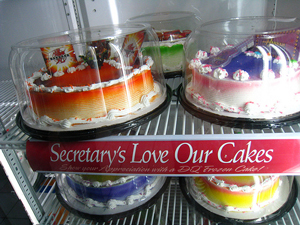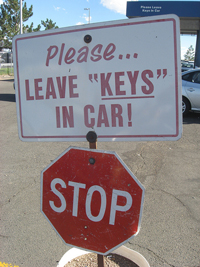Apostrophes

Source: Dairy Queen spelling mistake, RosiTulips, Flickr
O, Apostrophe! What is your lure? Why do some, like this bakery’s sign maker, insert you in unnecessary places? If more than one secretary loves these cakes, wouldn’t the simple plural, “secretaries,” do?
Other people add unnecessary apostrophes to proper names as in, “The Simpson’s grounded Homer.” In this example, the apostrophe after the iconic surname “Simpson” is not needed. When making a name plural, you don’t need an apostrophe before the s. Another redundant and incorrect use of apostrophes is to add them to possessive pronouns, as in ours’ and whose’.
Apostrophes already have plenty of legitimate punctuation tasks. Writers use them to take the place of missing letters in contractions. Apostrophes also indicate more than one letter of the alphabet, as in “How many A’s did you get?” They are the heavy lifters for showing possession too, as in barber’s shears. Watch this video clip, as a barber explains singular and plural possession.
Some words in the sentences below have unnecessary apostrophes. Other words need apostrophes because they’re contractions, singular possessives (‘s), or plural possessives (s’). In the activity below, read each sentence and decide which choice corrects the sentence. (Note: This activity is adapted from text at PBworks.com.)

Quotation Marks
Quotation marks come in pairs, and it’s smart to use the pair when the ideas are not your own.
In the U.S., commas and periods go inside the quotation marks. Using quotation marks with other punctuation might seem confusing, but the rules are actually pretty simple. Go to this website hosted by the Online Writing Lab (OWL) at Purdue University and learn how to use commas, periods, semicolons, and question marks with quotations. In the box below, you will find more helpful information about using quotation marks from the OWL.

Source: pet peeve, hotdiggitydogss, Flickr
- Direct quotations involve incorporating another person’s exact words into your own writing.
- Quotation marks always come in pairs. Do not open a quotation and fail to close it at the end of the quoted material.
- Capitalize the first letter of a direct quote when the quoted material is a complete sentence.
- Do not use a capital letter when the quoted material is a fragment or only a piece of the original material’s complete sentence.
- If a direct quotation is interrupted mid-sentence, do not capitalize the second part of the quotation.
- Quotations are most effective if you use them sparingly and keep them relatively short. Too many quotations in a research paper will get you accused of not producing original thought or material. (They may also bore a reader who wants to know primarily what YOU have to say on the subject.)
Mr. Johnson, who was working in his field that morning, said, “The alien spaceship appeared right before my own two eyes.”
Although Mr. Johnson has seen odd happenings on the farm, he stated that the spaceship “certainly takes the cake” when it comes to unexplainable activity.
“I didn’t see an actual alien being,” Mr. Johnson said, “but I sure wish I had.”
Follow these tips and you’ll soon be using quotation marks like an expert. You can quote me on that.